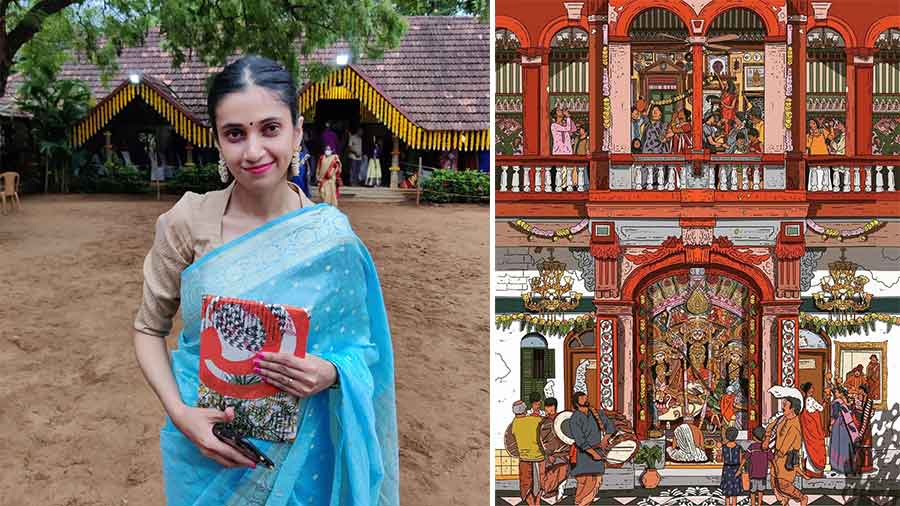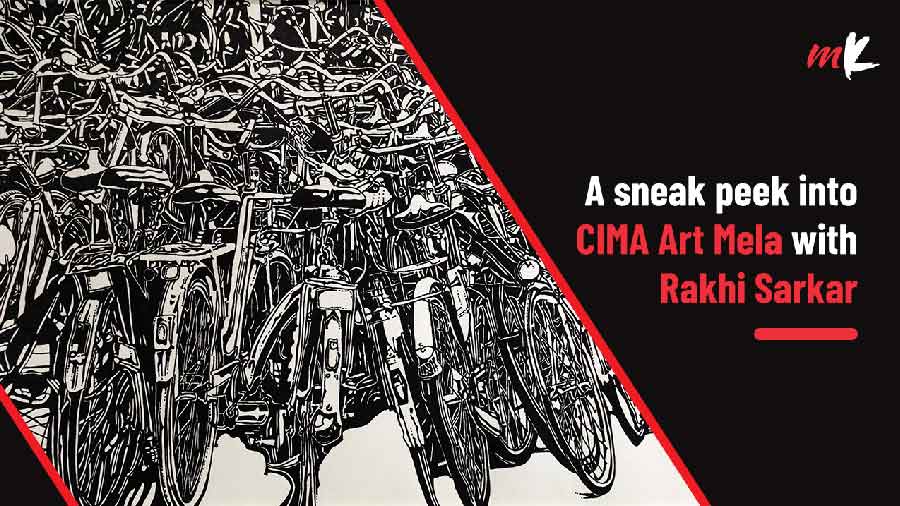You might have come across her extremely detailed 1,000-piece jigsaw puzzles on Instagram, which bring together history, art and culture. Offline, Surabhi Banerjee is an architect-illustrator who is simply fascinated by capturing the world around her. Born in Kolkata, raised in Mumbai and currently based in Bangalore, Banerjee shared her learnings from balancing two careers in art, going independent with illustrations, and the demands of social media algorithms on artists in a chat with My Kolkata. Excerpts from the conversation…
My Kolkata: Tell us a bit about your childhood and initial interest in art.
Surabhi Banerjee: I had a strange obsession with ‘things’ as a child. Growing up, I was always drawn to my grandparents’ house in Kolkata, which was filled with knick-knacks. To me, these seemed to be treasures from all over the world and I soon began collecting badges, rocks, bottle caps and matchboxes. All of these have stuck with me and are now reflected in my drawings, as I aim to carefully fill my work with all kinds of trivia.
I’ve been drawing for as long as I can remember, but I was also simultaneously building things. I think each one has informed the other and I often had crayon in one hand and Knex in the other. As I grew up, architecture ended up being an obvious choice when the time came to choose my profession.
Architecture was almost like a sanctuary for me at a time when my peers were allowed to pick from only a handful of exalted, well-paying career paths. It was where I got a chance to explore my puny ideas both physically and visually and I think I’ll always have a foot in both camps. Because it took me a long time to realise that illustration could be a career, I started out having given myself no other alternative but to only pursue the art of building spaces.
You straddle the worlds of architecture and illustration. How did you develop an interest in both?
I believe that architecture is the reason for my experimentation in different art styles, leading me to a career in illustration. My illustrations are heavily influenced by all that I have learned from architecture school (Kamla Raheja Vidyanidhi Institute for Architecture and Environmental Studies) and professional career as an architect, where we were introduced to a widely diverse set of drawings each semester. My teachers and mentors have persistently nudged me to challenge myself in drawings for architectural juries, competition entries and even client meetings. The difference between my illustrations and architectural drawings is the fictional aspect I try to incorporate in the former. In my artwork, I get to annihilate the rules of structure and physics and focus more on the story. Maybe I’m satisfied to be operating somewhere in the no-man’s-land in between them.
What inspires your art?
While I think artwork in itself has the power to move you, I don’t necessarily allow the medium to distract me from the idea of the drawing. Much of my work is inspired by the comics I have read and the graphic novels I have come to adore. I love the ‘Ligne Claire’ style started by Herge because it strips the image down to its bare form, with crisp line-work. I also admire Chris Ware’s Building Stories, that dissects a building and the lives that play out within it. His representation of deeply tragic themes with vivid colour palettes is particularly amazing. Richard McGuire’s Here is a unique concept too, almost like a collage, with a fixed view of a room comprising varying panel arrangements with links back and forward in time and space.
Take us through the process of setting up an online shop and independently taking your art to the people.
My professional career as an illustrator actually took off in the middle of the pandemic.
I had been working as an architect for almost three years, and felt lost and almost fraudulent towards the end. I had even enrolled into The Bartlett School of Architecture for an Urban Design course but both the pandemic and my absolute indecisiveness at the time pushed me towards an alternate path. Returning to drawing was like an act of self-affirmation and a pivotal lesson to myself in the importance of being sincere with my art. Informed purely by polls and suggestions I received on Instagram, I took the next step of turning the illustrations into physical prints. I set up a website to use as my portfolio, which gradually turned into a platform where one could also purchase my prints. Instagram advertisements came closely thereafter to facilitate the reach and engagement with more people.
Having amassed a considerable social media following, do you think it affects your art in any way? Is there a pressure to create for the algorithm?
I consider myself incredibly fortunate to have gained the number of followers I have in the past year, but have always considered the number of correspondences with people as an essential factor in my growth as an illustrator. In fact, I feel an air of success at the end of the day if I've had an email or DM from someone about my work. There was a brief time when I had the urgency to post every week lest I lose my rhythm, thereby losing people's attention and following. While that consistency helped me grow on Instagram, the pressure for creating new work and posting it was incredibly high. I found myself crumbling under the pressures of making new art, managing projects, deadlines and shipping. I felt the need to give up on the high that the algorithm gave me and inevitably lose a few people along the way. I’m learning and practising alternate ways to deal with this everyday, especially since the change in algorithm is incalculable. It’s important to internalise that nobody does their best work all the time, and learning what you don’t like doing is important when you’re trying to give expression to your voice. At the same time, it’s better to create forgettable work, than to not create at all.
How did you translate your art into creating jigsaw puzzles and postcards?
You can call me a connoisseur of puzzles. I absolutely adore them and have collected so many over the years. Besides it being a very personal interest, my illustration style made it the perfect product to launch a limited series of something more tactile and engaging. I think puzzles of these sizes (1,000 pieces) serve as an exploratory tool to help take a pause and slow down in an increasingly digital way of life. It serves many purposes; a reason to gather together with friends, an escape for individuals in search of quiet, games to be brought out at a party, or used as a form of tactile meditation throughout the day; puzzles can be very comforting.
A few of my friends and family had encouraged me to try and convert some of my prints into something affordable and adorable, that people could use daily and perhaps hang above their workspace. The scenes and intricacies of the illustrations also fit nicely as a set of postcards which could bring a dash of nostalgia to an ageing, tired ‘fridge gallery’.
Kolkata seems to be a recurring motif in your art. How has the city influenced your creative energy?
I was actually born in Kolkata and have lived a small portion of my life in New Alipore, but it is only recently that I’ve been bewitched by the city and have turned it into my official muse. Kolkata is a quintessential hotchpotch of colour, bustle and cacophony. For instance, my "Bajaar" illustration builds up around the periphery of municipal markets where street vendors, food stalls, flower baskets et al jostle for space with customers and even stray animals. Not to forget the iconic Kolkata symbols of phuchka walla, hand-pulled rickshaws, thela garis and yellow Ambassador taxis, all of which have seen better days but still somehow survive. I marvel at how so many people eke out a living in such a small space. The city is not just a riot of colours, but a wholesome treat for the senses, with a tinge of nostalgia leaving us with a sense of empathy for all the souls we encounter. There are other vignettes from Kolkata in my work, of which the Durga Pujo Thakur Dalan is a favourite of my family. I could draw the city every day for the rest of my life and not run out of material!

